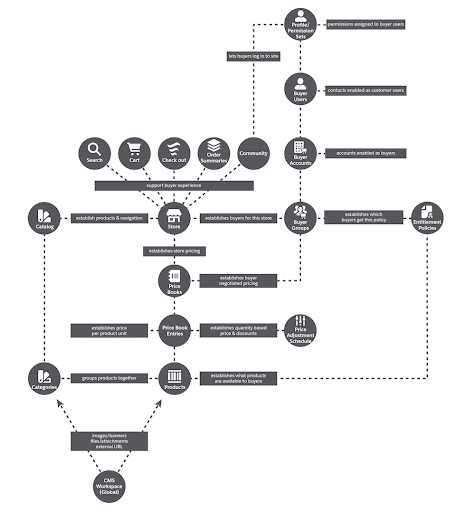Traditional B2B purchases can be quite a hassle. You might need to speak with a dedicated salesperson or account manager, and there can be a lot of hurdles and hoops to jump through. If you’re looking to get started with selling in the B2B space, getting the logistics in place can be cumbersome.
Salesforce B2B Commerce helps companies get set up quickly and easily, and it provides your customers with a seamless, self-serve experience for purchasing what they need. It takes a “cloud first” approach, and tailors your website to the specific needs of your industry.
Buyers need to log in when they visit your site, which allows Salesforce to personalize the storefront for each specific visitor. They can quickly reorder previous purchases, which is especially helpful when recurring orders are common, such as in the medical industry where supplies need to be restocked regularly. Any negotiated prices are visible to the customer as well, and buyers can also use shipping groups to send items to multiple locations on different dates.
Short on customer service reps? No problem! Salesforce B2B Commerce will set you up with a chatbot that can handle the majority of questions that your customers raise. And since it’s built on Salesforce, account managers and service agents can see commerce, CRM, service, and marketing data all in one place — across the business or at the contact level.
Setting up and managing your store is simple. Just follow a guided setup process to get started quickly. It’s easy to manage the store and make changes with drag-and-drop components designed for commerce, so you can implement in weeks and innovate fast to meet the changing needs of your customers.
Lightning v/s Visualforce B2B
Salesforce entered the B2B e-commerce world in 2018 with its acquisition of CloudCraze, a SaaS ‘B2B Commerce’ managed package application designed, built, and maintained on the Salesforce platform.
This platform was reworked to become “Salesforce B2B Commerce Classic”, also known as Visualforce B2B. Salesforce spun up a newer, modern version known as “Salesforce B2B Commerce Lightning Experience”. When you get started with selling online, you’ll need to decide which one to use.
Visualforce B2B –
Create a storefront with a set of Visualforce pages and components, installed from a managed package and integrated with your Experience Cloud site. Admins can manage storefront metadata, product catalogs, and certain buyer-facing features from a set of custom objects and custom settings. You can configure the default options to suit simple or complex B2B use cases. Because the storefront is built on Visualforce, developers can extend or override the default functionality throughout the application and fine-tune storefront behavior.
Lightning B2B
Create a store using the B2B Commerce template for Experience Builder. With B2B Commerce built directly on the Salesforce platform, admins can use Lightning Experience functionality to define buyer experiences, including search, carts, checkouts, and more. Admins and managers can import commerce data for accounts, products, price books, and entitlements using Data Loader or Data Import Wizard. They can also create, set up, and localize stores. Buyer managers can manage other buyer accounts. Store managers can update products and verify their store’s settings from the Commerce app.
Benefits of using Salesforce B2B
1.The ability to scale
The new sales channels that an e-commerce platform provides is a great way to reach new segments in the market, helping your organization to meet customers’ needs, grow, and scale to keep pace with demand.
2. Optimized productivity
Automation is central to e-commerce. Customers can simply place orders online, freeing up employees who can shift their focus toward the customer service experience. Salesforce B2B Commerce easily integrates with enterprise resource planning and other back-end systems.
3. More Customers
An important aspect to business is keeping up with trends, and online shopping is certainly the way shoppers are purchasing these days. If you did not previously have an online presence, you will now have your products introduced to new potential customers who are searching for your items.
4. Improved Brand Awareness
Even if your website visitors don’t convert, you’ve increased your brand’s visibility. If the customers haven’t heard of your business before, they definitely would after browsing your site. The ability to control your brand’s image online will help you grow and promote your brand locally and beyond.
5. Increased Sales
New customers obviously means more revenue! Not only that, you can now leverage the automated cross-selling and upsell recommendation tools that Salesforce provides. With this, you can display products to customers that they are likely to purchase based on their information, leading to even more growth!
6. Analytics capability
By selling your products through Salesforce B2B Commerce, you will have access to some of the best analytics tools on the market. This will help you to effectively measure your marketing campaigns, sales, inventory, customer engagement, and much more! You can then use these data points to make actionable insights to increase your online effectiveness.
Uniquely personalized customer experience
E-commerce is an enormous market that’s growing quickly worldwide. Consumers and businesses now demand a connected, online buying experience that meets their needs whether they are making large or small purchases. Salesforce B2B Commerce, with its powerful CRM, helps businesses harness their true potential.Its mobile-friendly design, AI-enabled CRM, AI-guided search results, and product recommendations ensure a uniquely personalized customer experience. Don’t just take our word for it, you can check out a demo here if you’d like to learn more!
Subscribe to our blog for more technical information and industry news.










